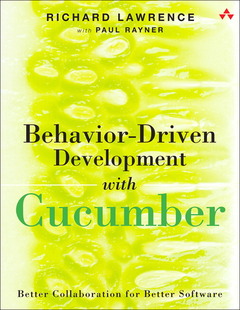Description
Behavior-Driven Development with Cucumber
Better Collaboration for Better Software
Authors: Lawrence Richard, Rayner Paul
Language: English
Subject for Behavior-Driven Development with Cucumber:
208 p. · 18x23 cm · Paperback
Description
/li>Contents
/li>Biography
/li>Comment
/li>
Master BDD to deliver higher-value software more quickly
To develop high-value products quickly, software development teams need better ways to collaborate. Agile methods like Scrum and Kanban are helpful, but they?re not enough. Teams need better ways to work inside each sprint or work item. Behavior-driven development (BDD) adds just enough structure for product experts, testers, and developers to collaborate more effectively.
Drawing on extensive experience helping teams adopt BDD, Richard Lawrence and Paul Rayner show how to explore changes in system behavior with examples through conversations, how to capture your examples in expressive language, and how to flow the results into effective automated testing with Cucumber. Where most BDD resources focus on test automation, this guide goes deep into how BDD changes team collaboration and what that collaboration looks like day to day. Concrete examples and practical advice will prepare you to succeed with BDD, whatever your context or role.
· Learn how to collaborate better by using concrete examples of system behavior
· Identify your project?s meaningful increment of value so you?re always working on something important
· Begin experimenting with BDD slowly and at low risk
· Move smoothly from informal examples to automated tests in Cucumber
· Use BDD to deliver more frequently with greater visibility
· Make Cucumber scenarios more expressive to ensure you?re building the right thing
· Grow a Cucumber suite that acts as high-value living documentation
· Sustainably work with complex scenario data
· Get beyond the ?mini-waterfalls? that often arise on Scrum teams
Chapter 1: Focusing on Value
When Scrum Isn’t Enough
Finding a High-Value Feature to Start With
Before You Start with Cucumber
Finding the First MMF
Slicing an MMF into User Stories
Summary
Reference
Chapter 2: Exploring with Examples
BDD Is a Cooperative Game
BDD Is a Whole Team Thing
Allow Time and Space to Learn
Flesh Out the Happy Path First
Use Real Examples
Example Mapping Gives the Discussion Structure
Optimizing for Discovery
Addressing Some Concerns
Treat Resistance as a Resource
Playing the BDD Game
Opening
Exploring
Closing
Summary
References
Chapter 3: Formalizing Examples into Scenarios
Moving from Examples to Scenarios
Feature Files as Collaboration Points
BDD Is Iterative, Not Linear
Finding the Meaningful Variations
Gherkin: A Language for Expressive Scenarios
Summary
Resources
Chapter 4: Automating Examples
The Test Automation Stack
Adjusting to Working Test-First
Annotating Element Names in Mockups
How Does User Experience Design Fit In to This?
Did They Really Just Hard Code Those Results?
Anatomy of a Step Definition
Simple Cucumber Expressions
Regular Expressions
Anchors
Wildcards and Quantifiers
Capturing and Not Capturing
Just Enough
Custom Cucumber Expressions Parameter Types
Beyond Ruby
Slow Is Normal (at First)
Choose Cucumber Based on Audience, Not Scope
Summary
Chapter 5: Frequent Delivery and Visibility
How BDD Changes the Tester’s Role
Exploratory Testing
BDD and Automated Builds
Faster Stakeholder Feedback
How Getting to Done More Often Changes All Sorts of Things
Frequent Visibility and Legacy Systems
Documentation: Integrated and Living
Avoiding Mini-Waterfalls and Making the Change Stick
Summary
References
Chapter 6: Making Scenarios More Expressive
Feedback About Scenarios
How to Make Your Scenarios More Expressive
Finding the Right Level of Abstraction
Including the Appropriate Details
Expressive Language in the Steps
Refactoring Scenarios
Good Scenario Titles
Summary
References
Chapter 7: Growing Living Documentation
What Is Living Documentation and Why Is It Better?
Cucumber Features and Other Documentation
Avoid Gherkin in User Story Descriptions
The Unexpected Relationship Between Cucumber Features and User Stories
Stable Scenarios
Growing and Splitting Features
Split When Backgrounds Diverge
Split When a New Domain Concept Emerges
Secondary Organization Using Tags
Structure Is Emergent
Summary
Chapter 8: Succeeding with Scenario Data
Characteristics of Good Scenarios
Independent
Repeatable
Researchable
Realistic
Robust
Maintainable
Fast
Sharing Data
When to Share Data
Raising the Level of Abstraction with Data Personas
Data Cleanup
Summary
Reference
Chapter 9: Conclusion
9780321772633 TOC 4/22/2019
Richard Lawrence is co-owner of the consulting firm Agile For All. He trains and coaches people to collaborate more effectively with other people to solve complex, meaningful problems. He draws on a diverse background in software development, engineering, anthropology, and political science.
Richard was an early adopter of behavior-driven development and led the development of the first .NET version of Cucumber, Cuke4Nuke. He is a popular speaker at conferences on BDD and Agile software development.
Paul Rayner co-founded and co-leads DDD Denver. He regularly speaks at local user groups and at regional and international conferences. If you are looking for an expert hands-on team coach and design mentor in domain-driven design (DDD), BDD with Cucumber, or lean/agile processes, Paul is available for consulting and training through his company, Virtual Genius LLC.
A¿guide to successfully implementing BDD with today’s #1 testing tool: Cucumber!
- Learn how to create business-facing automated tests that help you develop the right products
- Master the practice and the tool together, without time-consuming mistakes or costly consultants
- Automate functional tests for a wide variety of applications on Ruby, Java, and .NET (with exclusive coverage of Cuke4Duke for Java and Cuke4Nuke for .NET
- For the entire dev team: explains roles of all team members and stakeholders, especially non-developers
These books may interest you

Professional Scrum Team, The 33.83 €



